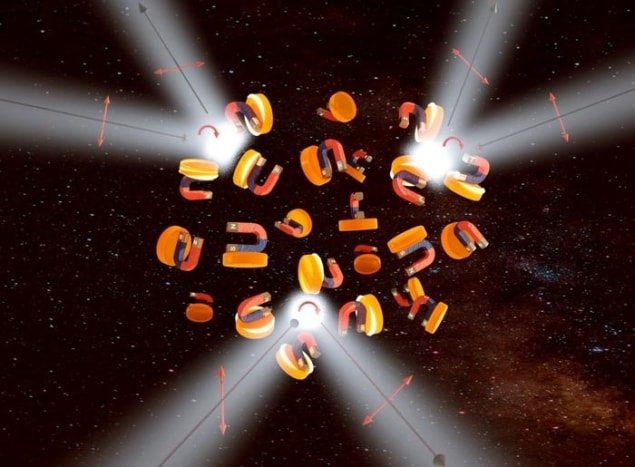New metamaterial could make true one-way glass
18 Mar 2024 Isabelle Dumé
The magnetic properties of a material can affect how it interacts with light. (Courtesy: Ihar Faniayeu/University of Gothenburg)
A proposed new optical metamaterial could behave like true one-way glass thanks to the Tellegen effect, which connects a material’s response to light waves with its magnetization and polarization. Under the design put forward by researchers in Finland, the US, Sweden and Greece, the new metamaterial would be formed from randomly oriented nanocylinders consisting of ferromagnets and a high-permittivity dielectric that operates at the right resonance. Unlike previous proposals, the metamaterial would not require external magnetic fields to operate, and its developers say it could also make solar cells more efficient.
The Tellegen effect is also known as the nonreciprocal magnetoelectric effect (NME), and it occurs when the electric field component of light (an electromagnetic wave) magnetizes a material at the same time as the magnetic field component polarizes it. The effect shows much promise for advanced technologies such as magnet-free optical isolators, as well as for fundamental research – for instance on the electrodynamics of relativistic matter and theoretical particles called axions.
Enhancing the effect through metamaterials
For light in the visible part of the electromagnetic spectrum, the NME in natural materials is negligible because the magnetization effect is weak, explains Shadi Safaei Jazi, a PhD student at Finland’s Aalto University who led the research. Most proposed approaches involving such materials only work for microwaves, and this is partly why the Tellegen effect has not been exploited in realistic industrial applications yet.
The magnetization component of the NME can, however, be enhanced in metamaterials and metasurfaces. These artificially engineered materials are structured in ways that give them properties such as a negative refractive index that are rare or absent in natural materials.
In the new work, which is detailed in Nature Communications, Safaei Jazi and colleagues describe a three-dimensional metamaterial that shows a strong Tellegen effect in the visible frequency range. This metamaterial would be formed from nanocylinders containing two components: a ferromagnetic nanodisc in a single-domain magnetic state, and a high-permittivity dielectric nanodisc that supports a so-called magnetic Mie-type resonance (a structural resonance at the level of the nanocylinder).
Spontaneous magnetization and the magnetoelectric effect
The researchers suggest that this 3D metamaterial could be made by randomly distributing the nanocylinders within a host medium such as water or a polymer. The ferromagnetic nanodiscs would exhibit spontaneous magnetization and the magnetoelectric effect (ME) without the need for an external magnetic field. Using conventional materials such as cobalt and silicon to make up the structure would increase the ME by two orders of magnitude compared to other known natural materials at room temperature, the team add.
The team also showed that using emerging materials such as magnetic Weyl semimetals in the metamaterial would enhance the ME even further, by almost four orders of magnitude. Weyl semimetals are a recently discovered class of topological material in which electrons behave like massless particles thanks to a special kind of symmetry in their electronic structure.
Seeing clearly in one direction
One potential application for such magnetoelectric colloids would be a true one-way glass, Safaei Jazi says. “Such a glass should not be confused with commercial semi-transparent reciprocal glass, which lets light through in both directions,” she explains. “Only when the brightness is different between the two sides (for example, inside and outside a window), does the latter act like a one-way glass.”
A true one-way glass based on the proposed magnetoelectric metamaterials would incorporate several layers of magnetoelectric coatings on top of a conventional glass surface, she continues. “Conventional technology for such a glass would require strong and bulky electromagnets surrounding the glass to create magnetization and break reciprocal light transmission. These electromagnets would completely obscure the view and make the system opaque to light in both directions.”READ MORE

Viktar Asadchy, an electro-optical engineer at Aalto and Stanford University who supervised the project, says that the team’s system would, in principle, show strong spontaneous magnetization and one-way light transmission without external magnetic fields. “This means that a window with that glass in your house, office, or car would allow you to enjoy a perfect view, regardless of the brightness outside, and people wouldn’t be able to see anything inside,” Asadchy says.
The proposed one-way glass could also make solar cells more efficient, Safaei Jazi tells Physics World. This is because it would block the thermal emissions that today’s cells radiate back towards the Sun, which reduces the amount of energy the cells can capture.

Isabelle Dumé is a contributing editor to Physics World
FROM PHYSICSWORLD.COM 27/3/2024

Δεν υπάρχουν σχόλια:
Δημοσίευση σχολίου